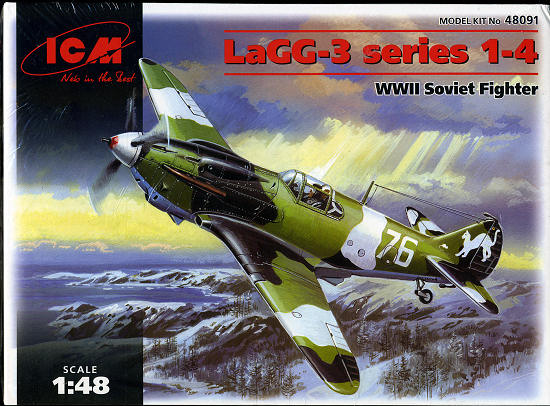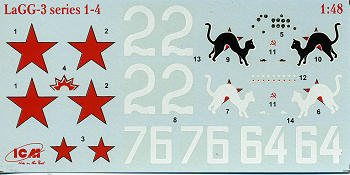
ICM 1/48 Lagg-3 Series 1-4
| KIT: | M |
| KIT #: | 48091 |
| PRICE: | $16.98 |
| DECALS: | Four options |
| REVIEWER: | Scott Van Aken |
| NOTES: | New mold kit |

| HISTORY |
The Lavochkin-Gorbunov-Goudkov LaGG-3 (Лавочкин-Горбунов-Гудков ЛаГГ-3) was a Soviet fighter aircraft of World War II. It was a refinement of the earlier LaGG-1, and was one of the most modern aircraft available to the Soviet Air Force at the time of Germany's invasion in 1941.
The main deficiency of the LaGG-1 design was power. A more powerful version of its Klimov M-105 engine was tried. The improvement was poor and without an alternative powerplant, the only solution was to lighten the airframe. The LaGG team re-examined the design and pared down the structure as much as possible. Fixed slats were added to the wings to improve climb and manoeuvrability and further weight was saved by installing lighter armament. The LaGG-3 replaced the LaGG-1 immediately.
The result was still not good enough although it came close to its rival Bf-109F in performance and was superior in maneuverability. Still, even with the lighter airframe and supercharged engine, the LaGG-3 was underpowered and proved immensely unpopular with pilots. The novel, wood-laminate construction of the aircraft continued to be poor quality (as with its predecessor) and pilots joked that rather than being an acronym of the designers' names (Lavochkin, Gorbunov, and Goudkov) "LaGG" stood for lakirovanny garantirovanny grob ("guaranteed varnished coffin" - лакированный гарантированный гроб). Some aircraft supplied to the front line were up to 40 km/h (25 mph) slower than they should have been and some were not airworthy. In combat, LaGG-3's main advantage was its strong airframe. Although the laminated wood did not burn it shattered severely when hit by high explosive rounds.
The LaGG-3 was improved during production, resulting in 66 minor variants in the 6,258 that were built. Experiments with fitting a large radial engine to the LaGG-3 airframe finally solved the power problem, and led to the superb Lavochkin La-5, though it also initially was fraught with problems.
| THE KIT |
 Most
of us have read about this kit already as it was released in Europe several
months ago. This is the first time I've seen it in person and I have to tell you
that I'm quite impressed and pleased with it. The surface detailing is
superlative with crisply done engravings and raised detail where needed. No mass
of rivets on this as the plane was basically covered in wood. The plastic does
have a slightly pebbly look to it, but not only will it effectively disappear
under paint, but will help to hold the paint in place.
Most
of us have read about this kit already as it was released in Europe several
months ago. This is the first time I've seen it in person and I have to tell you
that I'm quite impressed and pleased with it. The surface detailing is
superlative with crisply done engravings and raised detail where needed. No mass
of rivets on this as the plane was basically covered in wood. The plastic does
have a slightly pebbly look to it, but not only will it effectively disappear
under paint, but will help to hold the paint in place.
I did find some depressions on the fuselage side opposite thick internal details. There is also some flash on a few parts, but nothing of concern. The horrendous sink areas of ICM's early Spitfire moldings is a thing of the past.
It is obvious that ICM plans on doing several different variants of the Lagg-3 as there are a multiplicity of upper cowling panels, additional exhaust, spinners, and prop blades. The instructions also show the drop tanks and rockets to be 'not used'. I am pleased to see that ICM has stopped providing a full motor with its kits. While I'm sure some liked this, most people I know did not. The plus side is that one no longer has to fiddle and trim for what seems like ages to get the cowling panels to fit.
As it is a single engine prop fighter, there is not a lot of complexity to it. A well done cockpit with a clear instrument panel are provided. The interior sidewall detailing is excellent and will come alive with some proper painting, washing and dry brushing. The only real option is to have one or two upper cowling guns and both panels are supplied. One will have to look at the painting/markings guide to determine which is used.
 The
instructions are well drawn and provide Model Master and generic paint
names/numbers. Markings options are for four aircraft. One is the box art plane
from the 145th IAP based in Murmansk in 1941. This is in black, green and white
uppers with light blue undersides. This particular aircraft has a full color
painting guide on the back of the box. Second is from the 609 IAP, also based in
Murmansk in Black/Green upper with light blue underside. White 22 is in the same
colors but with a different pattern. It is from Leningrad's 44 IAP during 1941.
The final option is White 64, again in the standard scheme, but with large
areas painted in temp white with much of it washed off the fuselage. It is from
the 3rd GvIAP in Leningrad during early 1942. The decals are well printed and
matte. They include instruments for the clear instrument panel. I'm a tad leery
of ICM decals as in the past, I've not had good results from them. But one never
knows.
The
instructions are well drawn and provide Model Master and generic paint
names/numbers. Markings options are for four aircraft. One is the box art plane
from the 145th IAP based in Murmansk in 1941. This is in black, green and white
uppers with light blue undersides. This particular aircraft has a full color
painting guide on the back of the box. Second is from the 609 IAP, also based in
Murmansk in Black/Green upper with light blue underside. White 22 is in the same
colors but with a different pattern. It is from Leningrad's 44 IAP during 1941.
The final option is White 64, again in the standard scheme, but with large
areas painted in temp white with much of it washed off the fuselage. It is from
the 3rd GvIAP in Leningrad during early 1942. The decals are well printed and
matte. They include instruments for the clear instrument panel. I'm a tad leery
of ICM decals as in the past, I've not had good results from them. But one never
knows.
| CONCLUSIONS |
Well, now you can toss that LTD kit you've been hoarding for all these years or build it using some of the spare bits from this kit. ICM kits generally build quite well and I'm sure this one will be no exception. I've been waiting for this one to show up so you know this kit is headed straight for the 'to build' pile. Nice to see this aircraft finally properly kitted.
| REFERENCES |
http://en.wikipedia.org
October 2008
My thanks to www.dragonmodelsusa.com for the preview kit. You can get this on-line or at your favorite hobby shop. If they don't have it, have them get it for you.
If you would like your product reviewed fairly and quickly, please contact me or see other details in the Note to Contributors.